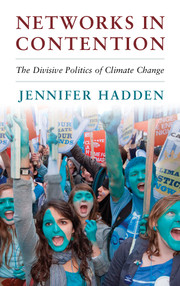Book contents
- Frontmatter
- Dedication
- Contents
- List of Figures
- List of Tables
- Acknowledgments
- Introduction
- 1 The Copenhagen Moment
- 2 The Emergence of a Divided Civil Society Network
- 3 A Network Approach to Collective Action
- 4 Conventional Climate Advocacy
- 5 Climate Justice Activism
- 6 Implications for Climate Change Politics
- Conclusion
- Main Abbreviations Used
- Methods Appendix
- References
- Index
- Books in the Series
3 - A Network Approach to Collective Action
Published online by Cambridge University Press: 05 April 2015
- Frontmatter
- Dedication
- Contents
- List of Figures
- List of Tables
- Acknowledgments
- Introduction
- 1 The Copenhagen Moment
- 2 The Emergence of a Divided Civil Society Network
- 3 A Network Approach to Collective Action
- 4 Conventional Climate Advocacy
- 5 Climate Justice Activism
- 6 Implications for Climate Change Politics
- Conclusion
- Main Abbreviations Used
- Methods Appendix
- References
- Index
- Books in the Series
Summary
It was clear by November 2009 that Copenhagen was going to be a very different kind of climate conference. In The Guardian's words:
Never mind the boring old delegates at next month's climate talks in Copenhagen … at events and actions around the city, the largest ever gathering of climate activists will take place which aims to create a global network that will take the environment movement forward for the next year and beyond … It's going to be the sort of fortnight where everywhere you look people are chained to railings with slogans written on their faces.
(Van der Zee 2009a)Copenhagen was a turning point in terms of the number of organizations that were willing to sponsor contentious collective action. As scholars have noted, before Copenhagen, “few groups ha[d] actively mobilized against the UN” (Smith 2008, 98; but see also Fisher 2004, 179). According to the data I use in this chapter, only 16 percent of organizations used contentious actions more than half of the time in 2008, whereas 58 percent did so in 2009. Sponsoring a contentious action can sour relations with authorities, members, and funders and can incur repressive reactions, making it potentially a costly choice for an organization. So why did so many organizations choose to adopt contentious tactics in this time period? Why did some organizations adopt these tactics while others did not? How did they make these decisions?
The argument I advance here is that organizational decision making is fundamentally relational: it depends on the actions of other organizations working in the same field. Drawing on social network analysis, I show that the ties that an organization has – where it is embedded in the overall network – are consequential for its tactical choices.
- Type
- Chapter
- Information
- Networks in ContentionThe Divisive Politics of Climate Change, pp. 63 - 88Publisher: Cambridge University PressPrint publication year: 2015



